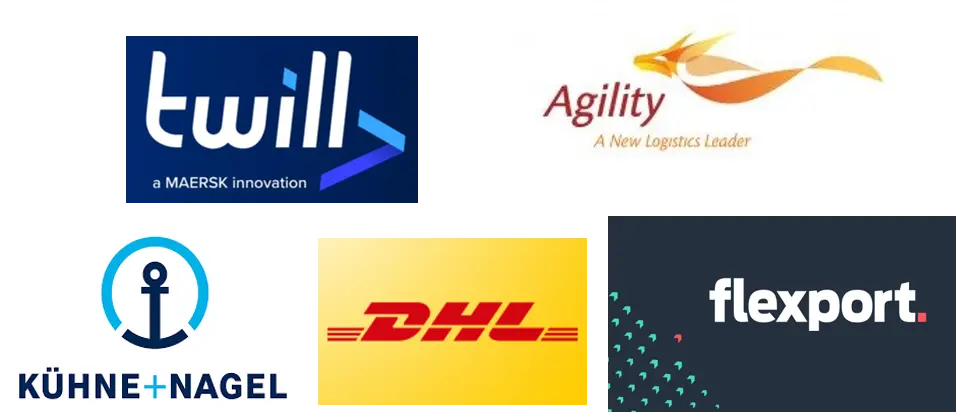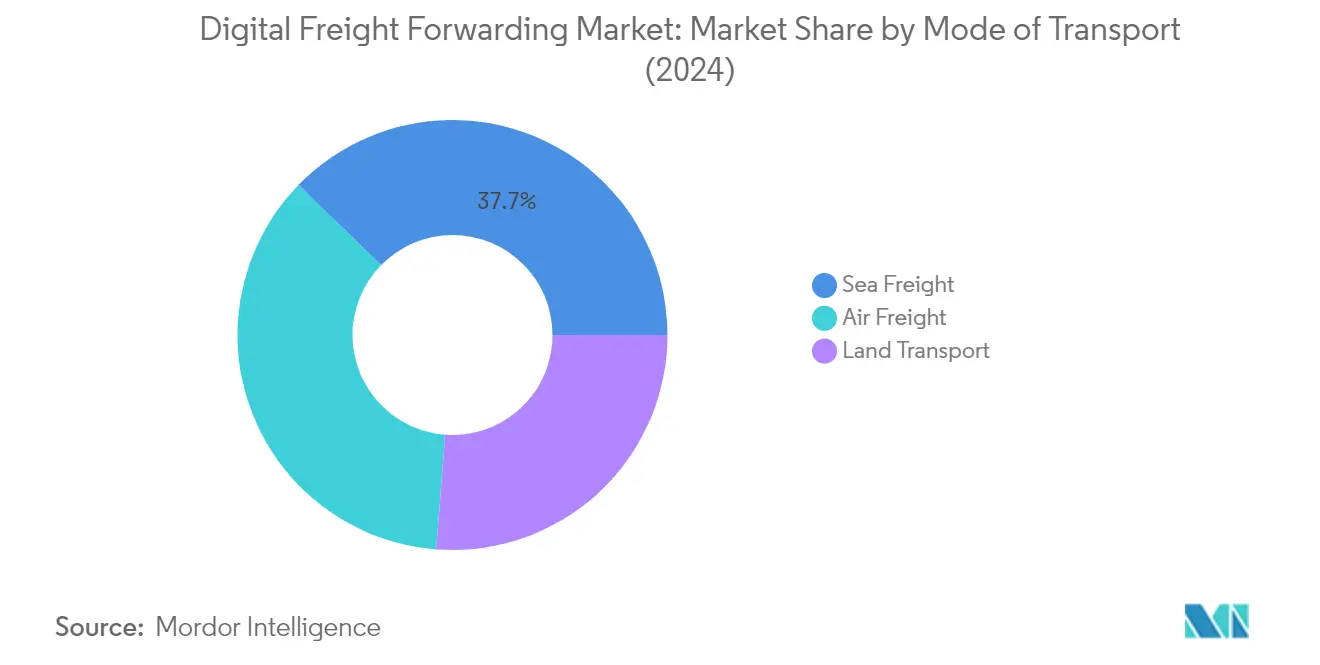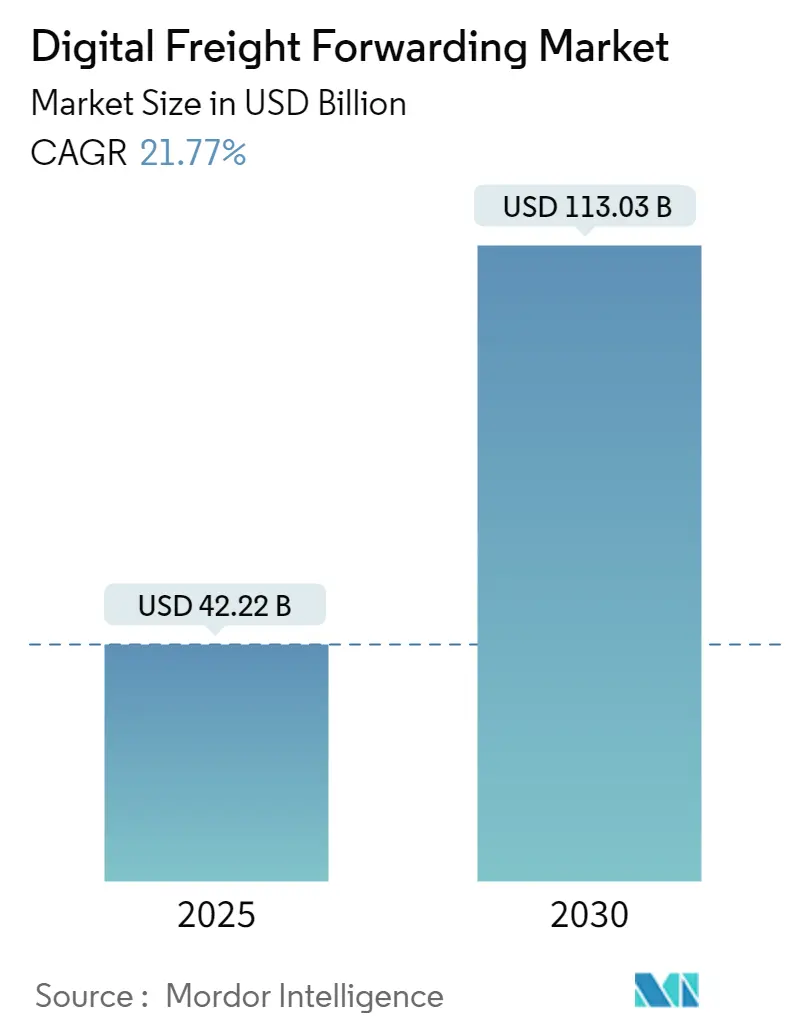
Digital Freight Forwarding Market Analysis
The Digital Freight Forwarding Market size is estimated at USD 42.22 billion in 2025, and is expected to reach USD 113.03 billion by 2030, at a CAGR of 21.77% during the forecast period (2025-2030).
The digital freight forwarding industry is undergoing a fundamental transformation as global trade patterns evolve and digitalization becomes increasingly critical for operational efficiency. Over 90% of global trade is transported by sea, with a significant portion of this digital freight forwarding business still heavily dependent on manual processes, spreadsheets, emails, and telephone calls. This traditional approach has created substantial inefficiencies in the global supply chain, prompting a shift toward digital solutions that offer enhanced visibility, better coordination, and streamlined operations. The industry is witnessing a rapid transition from paper-based documentation to electronic systems, with major players investing heavily in digital infrastructure to maintain a competitive advantage.
Technology adoption across the digital freight forwarding sector has accelerated significantly, with digital freight platforms emerging as the primary enablers of change. Leading platforms have demonstrated remarkable market penetration, exemplified by Freightera's network of over 13,000 businesses facilitating shipments between 23,000 communities across North America. These digital freight platforms are revolutionizing the traditional freight forwarding model by offering instant quotes, transparent pricing, real-time tracking capabilities, and automated documentation processes. The integration of advanced technologies such as blockchain, artificial intelligence, and the Internet of Things (IoT) is further enhancing the efficiency and transparency of freight operations.
The investment landscape in the digital freight forwarding market has remained robust, with significant funding rounds supporting technological innovation and market expansion. In 2023, several strategic partnerships have emerged to strengthen the industry's digital capabilities, such as the collaboration between KBX and OMNIA Partners, providing over 140,000 members access to advanced transportation capabilities and freight forwarding marketplace solutions. Additionally, BlueNode's partnership with Transport Canada for implementing AI-powered maritime shipping optimization demonstrates the growing emphasis on technological solutions in the sector. These partnerships are accelerating the industry's digital transformation while creating new opportunities for efficiency gains and service improvements.
Regulatory frameworks are evolving to support the digital transformation of freight forwarding operations. India's contemplation of a National Logistics Law aims to define various participants in the logistics space and create a light regulatory ecosystem, potentially reducing logistics costs from 14% of GDP to less than 10%. This regulatory evolution is accompanied by initiatives to standardize digital processes across borders, with various countries implementing policies to support the adoption of electronic documentation and digital platforms. Industry stakeholders are collaborating to establish common standards for data exchange and interoperability, ensuring seamless integration across different digital forwarding platforms and geographical regions.
Digital Freight Forwarding Market Trends
Growing E-commerce and Cross-border Trade
The explosive growth of global e-commerce has become a fundamental driver for digital freight forwarding adoption. With worldwide retail e-commerce sales reaching approximately 3.53 trillion US dollars in 2019, businesses are increasingly seeking efficient logistics solutions to manage their international shipments. This encompasses not just direct-to-consumer retail but also extends to various sectors, including electronics, pharmaceuticals, and consumer packaged goods, creating a robust demand for streamlined digital freight forwarding solutions that can handle complex cross-border transactions.
The surge in cross-border e-commerce, particularly in developing markets such as China, India, and Indonesia, has created an unprecedented need for sophisticated digital freight logistics solutions. Manufacturers and retailers are gradually transitioning from traditional freight forwarding methods to digital forwarding platforms that offer enhanced visibility, better control, and improved efficiency in managing international shipments. This shift is further accelerated by the growing preference of millennials for digital interfaces and the increasing comfort of businesses with online transactions for their logistics needs.
Technological Advancement and Digital Integration
The integration of advanced technologies such as blockchain, the Internet of Things (IoT), and artificial intelligence is revolutionizing the digital freight forwarding industry. Major industry players are investing significantly in developing comprehensive digital freight platforms that can handle everything from booking and documentation to tracking and analytics. For instance, companies like Maersk Line have partnered with technology giants to create blockchain-based platforms like TradeLens, which enable trust between multiple trading partners, including carriers, freight forwarders, customs authorities, and port operators.
The advancement in cloud computing and data analytics capabilities has enabled freight forwarders to offer more sophisticated services beyond basic transportation. Digital freight platforms are now capable of providing real-time rate comparisons, automated customs documentation, predictive analytics for optimal routing, and integrated supply chain visibility. These technological capabilities are particularly attractive to small and medium-sized enterprises (SMEs) who can now access global logistics services that were previously available only to large corporations with substantial resources.
Demand for Enhanced Supply Chain Visibility and Efficiency
The increasing complexity of global supply chains has created a strong demand for enhanced visibility and operational efficiency in freight forwarding. Digital freight platforms are addressing this need by providing real-time tracking capabilities, automated documentation processes, and transparent pricing mechanisms. This transformation is particularly evident in the way digital freight forwarders can provide instant quotes and comparative pricing across multiple carriers, enabling businesses to make informed decisions quickly and efficiently.
The drive for operational efficiency is further supported by the integration of various stakeholders in the supply chain through digital freight platforms. These platforms are enabling seamless communication between shippers, carriers, customs authorities, and other parties involved in the freight forwarding process. The ability to access and share information in real-time has significantly reduced processing times, minimized errors in documentation, and improved overall supply chain efficiency. For instance, digital freight platforms are now capable of reducing administrative supply chain costs by up to 30% while providing real-time data and on-time delivery information.
Strategic Industry Partnerships and Ecosystem Development
The formation of strategic partnerships between traditional freight forwarders and technology companies has become a crucial driver in the digital freight forwarding market. These collaborations are creating powerful ecosystems that combine the extensive logistics experience of traditional players with the innovative capabilities of technology companies. For example, major shipping lines are partnering with digital freight marketplaces to provide integrated services that cover the entire logistics chain, from booking to final delivery.
The development of comprehensive logistics ecosystems through partnerships is enabling more efficient and integrated services. Digital freight forwarders are establishing connections with various stakeholders, including customs authorities, warehousing providers, and last-mile delivery services, to create seamless end-to-end solutions. These partnerships are particularly significant in developing markets where the combination of local expertise and digital capabilities is essential for successful operations. The collaborative approach is also facilitating the standardization of processes and the development of industry-wide digital solutions that benefit all stakeholders in the freight forwarding ecosystem.
Segment Analysis: By Mode of Transport
Sea Freight Segment in Digital Freight Forwarding Market
The sea freight segment has emerged as the dominant force in the digital freight forwarding market, commanding approximately 38% of the total market share in 2024. This segment's leadership position is driven by the increasing digitalization of maritime shipping operations, with major shipping lines implementing blockchain technology and digital platforms for enhanced transparency and efficiency. The segment has particularly benefited from the integration of real-time tracking capabilities, automated documentation processes, and digital booking platforms that streamline container management and port operations. Additionally, the adoption of smart containers fitted with Remote Container Management (RCM) systems has revolutionized how cargo is monitored and managed across global shipping routes, providing end-to-end visibility and reducing operational costs for stakeholders throughout the maritime supply chain.
Air Freight Segment in Digital Freight Forwarding Market
The air freight segment in the digital shipment market has demonstrated remarkable technological advancement and innovation in recent years. The segment has embraced sophisticated digital solutions, including AI-powered route optimization, automated capacity management systems, and integrated booking platforms that connect freight forwarders directly with airlines. The transformation of traditional air cargo operations through digital initiatives like e-Air Waybills (e-AWB) and real-time tracking systems has significantly enhanced operational efficiency and customer experience. Furthermore, the integration of predictive analytics and machine learning algorithms has enabled better capacity utilization and dynamic pricing strategies, making air freight services more accessible and cost-effective for businesses of all sizes.
Remaining Segments in Digital Freight Forwarding Market
The land transport segment plays a crucial role in the digital freight shipping ecosystem, particularly in providing last-mile connectivity and regional distribution services. This segment has witnessed significant digital transformation through the implementation of advanced fleet management systems, real-time tracking solutions, and automated routing algorithms. The integration of digital platforms has revolutionized how trucking services are booked and managed, enabling better capacity utilization and reducing empty miles. Additionally, the segment has benefited from the emergence of freight forwarding platforms and online freight marketplaces that connect shippers directly with carriers, streamlining the entire booking and delivery process while providing enhanced visibility and control over ground transportation operations.
Digital Freight Forwarding Market Geography Segment Analysis
Digital Freight Forwarding Market in North America
North America represents one of the most technologically advanced markets for digital freight forwarding services. The region benefits from robust infrastructure, high digital adoption rates, and the presence of major technology companies driving innovation in logistics. The United States leads the regional market, followed by Canada and Mexico, with all three countries showing a strong commitment to the digitalization of freight services. The increasing cross-border trade within the USMCA (formerly NAFTA) region has created additional opportunities for digital freight forwarding companies, while the growing e-commerce sector continues to drive demand for efficient logistics services.
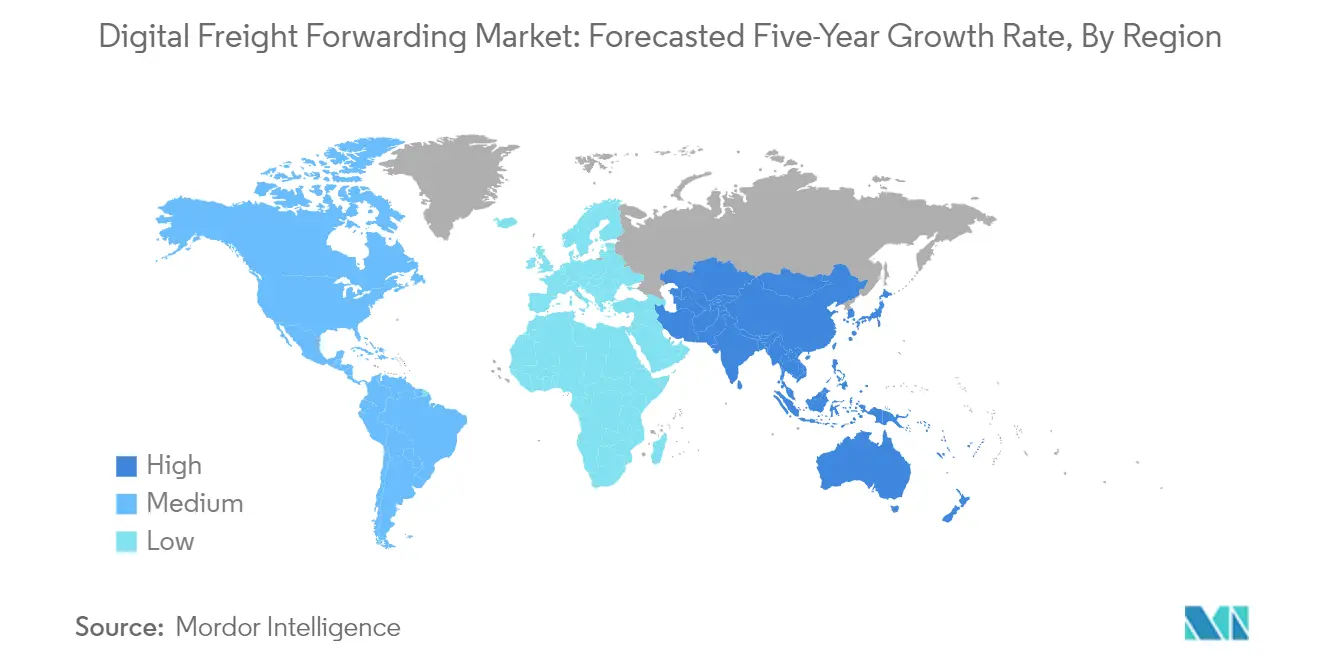
Digital Freight Forwarding Market in the United States
The United States dominates the North American digital freight forwarding landscape, accounting for approximately 84% of the regional market share in 2024. The country's leadership position is supported by its advanced technological infrastructure and the presence of major digital freight forwarding companies. The logistics industry is rapidly developing into a paperless, digitized sector, with major benefits including instant quotes, transparent pricing, rate comparisons, and enhanced tracking capabilities. Companies like Convoy, Uber Freight, and uShip are continuously introducing new platforms to address gaps in the logistics industry, while traditional players are accelerating their digital transformation efforts to maintain competitiveness.
Digital Freight Forwarding Market in Mexico
Mexico emerges as the fastest-growing market in North America, with a projected growth rate of approximately 24% during 2024-2029. The country's strategic position in cross-border trade with the United States has created significant opportunities for digital freight forwarding solutions. The cross-border cargo market between Mexico and the United States offers particular potential, with motor transport maintaining leadership in merchandise exchange between the two countries. Digital freight platforms are increasingly being adopted to streamline cross-border operations, offering enhanced visibility and efficiency in cargo movement.
Digital Freight Forwarding Market in Europe
Europe represents a sophisticated market for digital freight forwarding services, characterized by advanced infrastructure and high technology adoption rates. The region benefits from strong cross-border trade within the European Union, creating significant opportunities for online freight forwarding solutions. Germany leads the market, followed by France, the United Kingdom, the Netherlands, and Italy. The region's commitment to digital transformation and sustainability initiatives has accelerated the adoption of digital freight forwarding solutions across various industries.
Digital Freight Forwarding Market in Germany
Germany maintains its position as the largest digital freight forwarding market in Europe, commanding approximately 24% of the regional market share in 2024. The country's leadership is driven by its robust industrial base, central geographic location, and advanced technological infrastructure. The freight forwarding industry in Germany is rapidly catching up with digitization compared to other sectors, with both traditional players and new entrants investing significantly in digital transformation initiatives. The platform-based approach has gained significant traction, offering customers real-time data and on-time delivery capabilities.
Digital Freight Forwarding Market in the Netherlands
The Netherlands demonstrates the highest growth potential in Europe, with a projected growth rate of approximately 22% during 2024-2029. The country's strategic position as a key logistics hub, home to Europe's largest port in Rotterdam and proximity to major European markets, drives this growth. The Dutch market benefits from low technological barriers, strong pre-existing freight infrastructure, and a highly skilled workforce with extensive knowledge of the freight industry and trade. Online freight forwarding platforms are increasingly being adopted to optimize operations and enhance supply chain visibility.
Digital Freight Forwarding Market in Asia-Pacific
The Asia-Pacific region represents a dynamic market for digital freight forwarding services, characterized by diverse market conditions and varying levels of digital adoption across countries. The region encompasses major economies like China, Japan, and India, alongside developing markets such as Indonesia, Malaysia, and Singapore. The increasing cross-border trade, growing e-commerce sector, and government initiatives supporting digital transformation are driving market growth across the region.
Digital Freight Forwarding Market in China
China stands as the dominant force in the Asia-Pacific digital freight forwarding market. The country's vast logistics landscape, coupled with increasing adoption of technology by businesses and consumers, has created a robust environment for digital freight solutions. The digital transformation of the freight forwarding market is in its growth stage, with many medium and large players entering the market, either directly by adding new wings to their existing services or through collaboration with startups.
Digital Freight Forwarding Market in India
India emerges as the fastest-growing market in the Asia-Pacific region. The country's digital freight forwarders in India sector is experiencing rapid transformation, driven by government initiatives supporting digital adoption and the growing need for efficient logistics solutions. Technology-driven products and services are increasingly being adopted by shippers looking to improve their experience and reduce costs, while digital platforms are helping to break the traditionally relationship-based nature of international logistics.
Digital Freight Forwarding Market in Middle East & Africa
The Middle East & Africa region presents a growing market for digital freight forwarding services, with varying levels of digital adoption across different countries. The region encompasses South Africa, Egypt, and the GCC countries, each with distinct market characteristics and development stages. The GCC countries lead the regional market in terms of size, while Egypt shows the fastest growth potential, driven by increasing digitalization efforts and growing trade volumes.
Digital Freight Forwarding Market in South America
South America represents an emerging market for digital freight forwarding services, with Brazil and Chile as key markets driving regional growth. Brazil leads the market size in the region, while Chile demonstrates the fastest growth potential. The region's logistics landscape is undergoing significant digital transformation, particularly driven by the growing e-commerce sector and increasing adoption of digital services among transportation and logistics industry players.
Digital Freight Forwarding Industry Overview
Top Companies in Digital Freight Forwarding Market
The digital freight forwarding market is characterized by a mix of established logistics giants and innovative digital-native players. Companies are increasingly focusing on developing comprehensive digital platforms that offer end-to-end visibility, real-time tracking, and automated documentation processes. Strategic investments in cloud-based technologies and artificial intelligence are enabling providers to optimize routing, enhance predictive analytics, and streamline customs clearance procedures. Market leaders are expanding their service portfolios through strategic partnerships and acquisitions of technology startups, particularly those specializing in blockchain and IoT solutions. The industry is witnessing a significant push towards platform integration capabilities, with companies developing APIs to connect with various stakeholders across the supply chain ecosystem. Operational agility is being achieved through the implementation of mobile-first solutions and automated booking systems, while geographic expansion is primarily focused on emerging markets with high e-commerce growth potential. Among the leading digital freight forwarders, these strategies are critical for maintaining a competitive advantage.
Dynamic Market Structure Drives Industry Evolution
The digital freight forwarding landscape exhibits a fragmented structure with increasing competition from new entrants, particularly technology-driven startups backed by venture capital funding. Traditional freight forwarding giants are transforming their operations through digital initiatives and strategic acquisitions, while pure-play digital forwarders are gaining market share through innovative business models and superior customer experience. The market is witnessing a surge in merger and acquisition activities as established players seek to acquire digital capabilities and startups look to expand their geographic presence and service offerings. The competitive dynamics are further shaped by regional specialists who leverage their local expertise and relationships to maintain strong positions in specific markets.
The industry is experiencing a gradual shift towards consolidation as larger players aim to create integrated digital ecosystems that can serve diverse customer needs across multiple geographies. Global logistics conglomerates are investing heavily in digital transformation initiatives, while specialist providers are focusing on niche segments with specific technological requirements. The market is characterized by varying levels of digital maturity across regions, with developed markets showing higher adoption rates of advanced digital solutions. Partnership ecosystems are becoming increasingly important as companies seek to combine their strengths in technology, market presence, and operational expertise. This evolution is evident in the growing network of digital freight that connects diverse players across the industry.
Innovation and Integration Drive Future Success
Success in the digital freight forwarding market increasingly depends on the ability to provide seamless, integrated solutions that address the entire supply chain spectrum. Incumbent players must focus on developing user-friendly interfaces, enhancing data analytics capabilities, and building robust integration frameworks to maintain their market position. The ability to offer customized solutions while maintaining operational efficiency through automation and artificial intelligence will be crucial for market leadership. Companies need to invest in building strong cybersecurity frameworks and ensuring compliance with evolving regulatory requirements across different jurisdictions. Customer experience and service reliability are becoming key differentiators as the market matures and end-users become more sophisticated in their digital requirements.
For new entrants and contenders, success lies in identifying and exploiting specific market niches or technological gaps in the current offerings. The focus should be on developing specialized solutions that address particular pain points in the freight forwarding process while maintaining flexibility to adapt to changing market conditions. Building strong partnerships with established players in complementary areas can help overcome barriers to entry and accelerate market penetration. Companies must also consider the increasing concentration of end-users in certain industries and develop industry-specific expertise and solutions. The risk of substitution remains relatively low due to the complex nature of international freight forwarding, but providers must continuously innovate to stay ahead of emerging technologies and changing customer preferences. As digital freight companies continue to evolve, their ability to integrate innovative solutions will determine their success in the competitive landscape.
Digital Freight Forwarding Market Leaders
-
Flexport
-
FreightHub
-
Twill
-
Agility Logistics
-
DHL
- *Disclaimer: Major Players sorted in no particular order
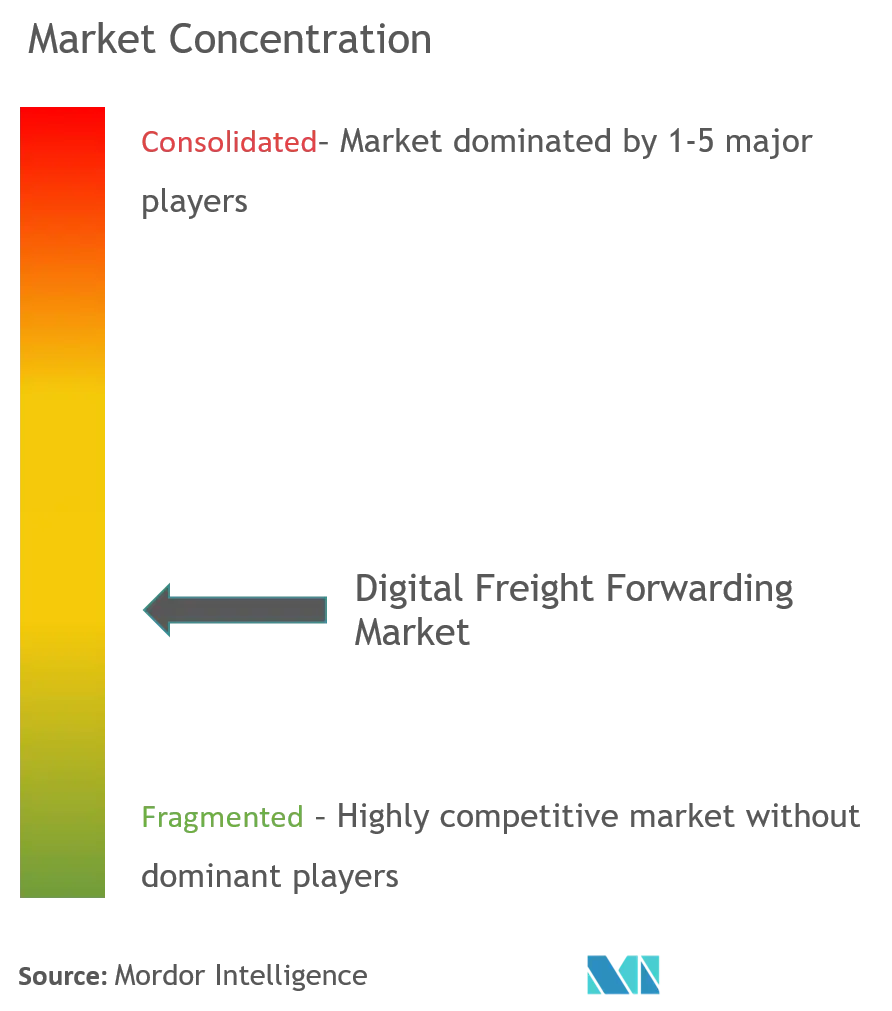
Digital Freight Forwarding Market Report - Table of Contents
1. INTRODUCTION
- 1.1 Study Deliverables
- 1.2 Study Assumptions
- 1.3 Scope of the Study
2. RESEARCH METHODOLOGY
- 2.1 Analysis Methodology
- 2.2 Research Phases
3. EXECUTIVE SUMMARY
4. MARKET INSIGHTS
- 4.1 Current Market Scenario
- 4.2 Value Chain / Supply Chain Analysis
- 4.3 Investment Scenarios
- 4.4 Government Regulations and Initiatives
- 4.5 Technology Development in Online Freight Forwarding and Digital Platforms
- 4.6 Overview on E-commerce Logistics and Freight Forwarding
- 4.7 Value Propositions of E-platforms Vs Competitors
- 4.8 Impact of Covid-19 on the Market
5. MARKET DYNAMICS
- 5.1 Drivers
- 5.2 Restraints
- 5.3 Opportunities
-
5.4 Industry Attractiveness - Porter's Five Forces Analysis
- 5.4.1 Bargaining Power of Suppliers
- 5.4.2 Bargaining Power of Consumers
- 5.4.3 Threat of New Entrants
- 5.4.4 Threat of Substitutes
- 5.4.5 Intensity of Competitive Rivalry
6. MARKET SEGMENTATION
-
6.1 By Mode of Transport
- 6.1.1 Land
- 6.1.2 Sea
- 6.1.3 Air
-
6.2 By Geography
- 6.2.1 North America
- 6.2.1.1 United States
- 6.2.1.2 Canada
- 6.2.1.3 Mexico
- 6.2.2 Europe
- 6.2.2.1 Germany
- 6.2.2.2 France
- 6.2.2.3 Netherlands
- 6.2.2.4 United Kingdom
- 6.2.2.5 Italy
- 6.2.2.6 Rest of Europe
- 6.2.3 Asia-Pacific
- 6.2.3.1 China
- 6.2.3.2 Japan
- 6.2.3.3 Australia
- 6.2.3.4 India
- 6.2.3.5 Singapore
- 6.2.3.6 Malaysia
- 6.2.3.7 Indonesia
- 6.2.3.8 South Korea
- 6.2.3.9 Rest of Asia-Pacific
- 6.2.4 Middle East & Africa
- 6.2.4.1 South Africa
- 6.2.4.2 Egypt
- 6.2.4.3 GCC Countries
- 6.2.4.4 Rest of Middle East & Africa
- 6.2.5 South America
- 6.2.5.1 Brazil
- 6.2.5.2 Chile
- 6.2.5.3 Rest of South America
7. COMPETITIVE LANDSCAPE
- 7.1 Market Concentration Overview
-
7.2 Company Profiles
- 7.2.1 Flexport
- 7.2.2 Twill
- 7.2.3 FreightHub
- 7.2.4 Fleet
- 7.2.5 InstaFreight
- 7.2.6 Transporteca
- 7.2.7 Kontainers
- 7.2.8 KN Freight Net
- 7.2.9 Turvo
- 7.2.10 iContainers
- 7.2.11 DHL Group
- 7.2.12 Kuehne + Nagel International AG
- 7.2.13 Agility Logistics Pvt. Ltd*
- *List Not Exhaustive
8. MARKET OPPORTUNITIES AND FUTURE TRENDS
9. DISCLAIMER
Digital Freight Forwarding Industry Segmentation
Digital Freight Forwarding Market report provides insights on the market like Market Overview, Market Dynamics, Value Chain / Supply Chain Analysis, Investment Scenarios, Government Regulations and Initiatives, Technology Development in Online Freight Forwarding and Digital Platforms, Overview on E-commerce Logistics and Freight Forwarding, Value Propositions of E-platforms Vs Competitors and Industry Attractiveness - Porter's Five Forces Analysis. The report also covers impact of Covid-19 on the market.
Furthermore, the report also provides company profiles with leading market players to understand the competitive landscape of the market.
| By Mode of Transport | Land | ||
| Sea | |||
| Air | |||
| By Geography | North America | United States | |
| Canada | |||
| Mexico | |||
| Europe | Germany | ||
| France | |||
| Netherlands | |||
| United Kingdom | |||
| Italy | |||
| Rest of Europe | |||
| Asia-Pacific | China | ||
| Japan | |||
| Australia | |||
| India | |||
| Singapore | |||
| Malaysia | |||
| Indonesia | |||
| South Korea | |||
| Rest of Asia-Pacific | |||
| Middle East & Africa | South Africa | ||
| Egypt | |||
| GCC Countries | |||
| Rest of Middle East & Africa | |||
| South America | Brazil | ||
| Chile | |||
| Rest of South America | |||
Digital Freight Forwarding Market Research FAQs
How big is the Digital Freight Forwarding Market?
The Digital Freight Forwarding Market size is expected to reach USD 42.22 billion in 2025 and grow at a CAGR of 21.77% to reach USD 113.03 billion by 2030.
What is the current Digital Freight Forwarding Market size?
In 2025, the Digital Freight Forwarding Market size is expected to reach USD 42.22 billion.
Who are the key players in Digital Freight Forwarding Market?
Flexport, FreightHub, Twill, Agility Logistics and DHL are the major companies operating in the Digital Freight Forwarding Market.
What years does this Digital Freight Forwarding Market cover, and what was the market size in 2024?
In 2024, the Digital Freight Forwarding Market size was estimated at USD 33.03 billion. The report covers the Digital Freight Forwarding Market historical market size for years: 2020, 2021, 2022, 2023 and 2024. The report also forecasts the Digital Freight Forwarding Market size for years: 2025, 2026, 2027, 2028, 2029 and 2030.
Our Best Selling Reports
Digital Freight Forwarding Market Research
Mordor Intelligence brings extensive expertise in analyzing the digital freight forwarding industry. We offer comprehensive insights into this rapidly evolving sector. Our detailed research covers the entire spectrum of digital freight platforms and digital forwarding solutions. We examine how digital freight companies are transforming traditional logistics operations. The report provides an in-depth analysis of digital freight marketplace dynamics, online freight platforms, and emerging digital freight networks. This information is available in an easy-to-read report PDF format for immediate download.
Stakeholders across the global freight forwarding industry benefit from our thorough examination of digital shipment market trends and technological innovations. The report details the expanding scope of digital freight forwarding solutions and their impact on traditional forwarding methods. It also analyzes the market size for digital freight forwarding across various regions. Our research particularly focuses on digital forwarding platforms and their integration with existing logistics infrastructure. This provides valuable insights for businesses looking to optimize their freight operations through digital transformation.

